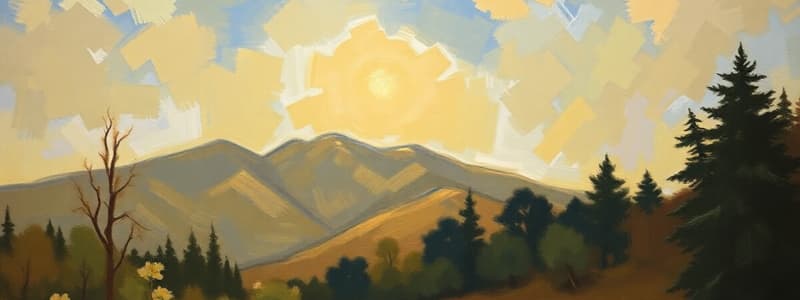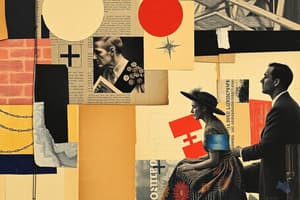Podcast
Questions and Answers
What is the primary focus when responding to a piece of art, even if a formal thesis isn't required?
What is the primary focus when responding to a piece of art, even if a formal thesis isn't required?
- Developing a complex argument about the artwork's historical significance.
- Identifying the artist's intentions and motivations.
- Considering your main position or viewpoint on the artwork. (correct)
- Researching the critical reception and analysis of the piece.
Which of the following is a crucial first step in responding to a work of art?
Which of the following is a crucial first step in responding to a work of art?
- Formulating a complex thesis statement.
- Researching the artist's biography and influences.
- Closely observing and describing the work's details. (correct)
- Critiquing the artistic techniques employed.
Understanding the 'context' of a piece of art primarily involves:
Understanding the 'context' of a piece of art primarily involves:
- Analyzing its influence on subsequent artistic movements.
- Deconstructing the artistic elements and techniques used.
- Considering the historical and social circumstances surrounding its creation. (correct)
- Evaluating its aesthetic qualities and artistic merit.
Focusing on what is 'not' present in a work of art can be particularly revealing for understanding:
Focusing on what is 'not' present in a work of art can be particularly revealing for understanding:
The purpose of 'prewriting' is to:
The purpose of 'prewriting' is to:
In Magritte's painting of a pipe, the contrast between the simple background and the surprising message serves to:
In Magritte's painting of a pipe, the contrast between the simple background and the surprising message serves to:
Monet's close-up focus and loose brushstrokes in his water lilies paintings aim to:
Monet's close-up focus and loose brushstrokes in his water lilies paintings aim to:
What is a crucial aspect of writing effective responses to various art forms?
What is a crucial aspect of writing effective responses to various art forms?
When describing a sculpture of a seemingly sad woman, what should an effective response include?
When describing a sculpture of a seemingly sad woman, what should an effective response include?
What is the primary goal of writing a response to an art form?
What is the primary goal of writing a response to an art form?
What should a good response avoid?
What should a good response avoid?
What is one common mistake students make when writing responses to art?
What is one common mistake students make when writing responses to art?
What is the significance of a thesis statement in a response to art?
What is the significance of a thesis statement in a response to art?
How do responses to other art forms relate to literary responses?
How do responses to other art forms relate to literary responses?
When writing about a film, what kind of details should be included in a good response?
When writing about a film, what kind of details should be included in a good response?
Flashcards
Thesis
Thesis
The main argument or position in a paper or essay.
Response Paper
Response Paper
A type of writing that expresses personal opinions about a work.
Context
Context
The events surrounding the creation of a work of art.
Prewriting
Prewriting
Signup and view all the flashcards
Details in Art
Details in Art
Signup and view all the flashcards
Absence in Art
Absence in Art
Signup and view all the flashcards
Monet's Technique
Monet's Technique
Signup and view all the flashcards
Qualities of a Good Response
Qualities of a Good Response
Signup and view all the flashcards
Specific, Clear Details
Specific, Clear Details
Signup and view all the flashcards
Thoughtful Reflection
Thoughtful Reflection
Signup and view all the flashcards
Descriptive Explanations
Descriptive Explanations
Signup and view all the flashcards
Thesis Development
Thesis Development
Signup and view all the flashcards
Engagement with Artwork
Engagement with Artwork
Signup and view all the flashcards
Avoiding Simple Statements
Avoiding Simple Statements
Signup and view all the flashcards
Basic Artistic Facts
Basic Artistic Facts
Signup and view all the flashcards
Study Notes
Writing Responses to Non-Literary Art Forms
- Writing about art forms like photographs, sculptures, and films shares core principles with literary analysis.
- Good responses focus on specific details, demonstrating thoughtful consideration of the artwork.
Qualities of a Strong Response
- Specific and Clear Details: A thorough response provides detailed descriptions of the artwork, focusing on elements like posture, head angles, and expressions in a sculpture or visuals and sounds in a film.
- Evidence of Thoughtful Analysis: Responses need to demonstrate understanding & reflection on the work, going beyond basic facts & presenting personal opinions.
- Explanatory Opinions: Avoid vague statements like "I liked it." Instead, explain why a certain aspect of the artwork resonates with you, using clear and detailed reasoning. A well-defined thesis supporting the main argument is crucial.
Approaches to Writing Responses
- What is in the piece?: A key element is describing precisely the visual and thematic elements of the artwork. Details, materials, and composition are critical components of a strong response.
- Context of the piece?: Analyze the historical, societal, or personal context in which the work was created. Understanding the background can provide additional context and insights.
- What is not in the work?: Think about what's absent from a piece. Missing elements can be just as significant as visible ones, especially in visual arts. Look for implicit meaning behind absences.
- Prewriting exercises: Start by brainstorming responses to questions about the artwork, focusing on details and observations without worrying about structure.
Example Art Responses
- Magritte's "This is not a pipe": The painting's effectiveness lies in its visual elements. The font style is subtle, but the 'p's resemble pipes, making the text itself a visual aspect. The simple background complements the shocking statement, drawing you into the interplay of language and image.
- Monet's Water Lilies: Monet's painting uses loose brushstrokes to depict a close-up view of water lilies, highlighting the complexity of experience. Details like the unseen pond shape, surroundings reflected, and multiple layers (under water, water, reflection) add depth to the artwork. Focus on the "what's not there" to understand how Monet illustrates human experience.
Studying That Suits You
Use AI to generate personalized quizzes and flashcards to suit your learning preferences.




